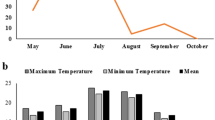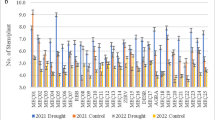Summary
Genotypic variation in the adaptation of potatoes of several maturity classes to the specific climatological conditions of the autumn season, to the high summer temperatures and to water deficit, was studied. Late-maturing cultivars exhibited the highest yielding potential both in the spring and autumn seasons but specific compatibility of cultivars to the autumn was detected. The late-maturing cultivars were more susceptible to high temperatures than were the early ones. However, there were significant differences in susceptibility to high temperatures among cultivars of the same maturity class. Susceptibility to water deficit was similar in the various maturity classes, but there were differences in the susceptibility to drought among cultivars of the same maturity class. High yielding potential generally resulted also in acceptable tuber yields under conditions of water deficit. High temperatures in combination with a water deficit aggravated yield losses, especially in the late-maturing cultivars.
Similar content being viewed by others
References
Begg, J. E. & N. C. Turner, 1976. Crop water deficits.Advances in Agronomy 28: 161–217.
Bodlaender, K. B. A., 1963. Influence of temperature, radiation and photoperiod on development and yield. In: The Growth of the Potato. Proceedings of the 10th Easter School of Agricultural Science, University of Nottingham, U.K., p. 199–210.
Ewing, E. E., 1981. Heat stress and tuberization stimulus.American Potato Journal 58: 31–49.
Harris, P. M., 1978. Water. In: The Potato Crop. The Scientific Basis for Improvement. Chapman & Hall, London, p. 245–275.
Jones, H. G., 1980. Interaction and integration of adaptive responses to water stress: The implications of an unpredicted environment. In: Turner, N. C. & P. J. Kramer (Eds), Adaptation of Plants to Water and High Temperature Stress. John Wiley & Sons, New York, N.Y., p. 353–365.
Levitt, J., 1980. Response of plants to environmental stresses. Academic Press, London, 607 pp.
Levy, D., 1978. Heat tolerance in potatoes and its effect on tuber yielding capacity in hot climates.Israel Journal of Botany 27: 35.
Levy, D., 1984. CultivatedSolanum tuberosum L. as a source for the selection of cultivars adapted to hot climates.Tropical Agriculture 61: 167–170.
Levy, D., 1986a. Genotypic variation in the response of potatoes (Solanum tuberosum L.) to high ambient temperatures and water deficit.Field Crops Research 15: 85–96.
Levy, D., 1986b. Tuber yield and tuber quality of several potato cultivars as affected by seasonal high temperatures and by water deficit in a semi-arid environment.Potato Research 29: 95–107.
Levy, D., L. Livesku & D. E. van der Zaag, 1986. Double cropping of potatoes in a semi-arid environmental: the association of ground cover with tuber yields.Potato Research 29: 437–449.
Loon, C. D. van, 1981. The effect of water stress on potato growth, development and yield.American Potato Journal 58: 51–70.
Lynch, D. R. & G. C. Kozub, 1988. An analysis of the response of nine potato genotypes to five prairie environments.Canadian Journal of Plant Science 68: 1219–1228.
Marshall, H. G., 1982. Breeding for tolerance to heat and cold. In: Christiansen, M. N. & C. F. Lewis (Eds), Breeding Plants for Less Favorable Environments, John Wieley & Sons, New York, NY, p. 47–70.
Simmonds, N. W., 1971. The potential of potatoes in the tropics.Tropical Agriculture 48: 291–299.
Slomnicki, I., 1960. Screening potato varieties for short day dormancy.European Potato Journal 4: 201–210.
Slomnicki, I., 1961. Potato growing two seasons a year from local seeds in Israel. In: Advances in Horticultural Science and their Applications. Proc. International Horticultural Congress, (Nice, France), Vol. I, p. 476–481.
Author information
Authors and Affiliations
Additional information
Contribution from the Agricultural Research Organization, The Volcani Center, Bet Dagan, Israel. No. 2782-E, 1989 series.
Rights and permissions
About this article
Cite this article
Levy, D., Genizi, A. & Goldman, A. Compatibility of potatoes to contrasting seasonal conditions, to high temperatures and to water deficit: The association with time of maturation and yield potential. Potato Res 33, 325–334 (1990). https://doi.org/10.1007/BF02359306
Accepted:
Issue Date:
DOI: https://doi.org/10.1007/BF02359306




